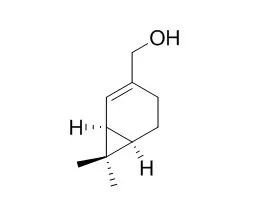| Structure Identification: |
| Food & Chemical Toxicology An International Journal Published for the British Industrial Biological Research Association, 2010, 48(8):2186-2192. | | Chemical composition and biological activities of Tunisian Cuminum cyminum L. essential oil: A high effectiveness against Vibrio spp. strains.[Reference: WebLink] |
METHODS AND RESULTS:
Essential oil extracted by hydrodistillation from Tunisian variety of Cuminum cyminum was characterized by means of GC and GC–MS. Twenty-one components were identified and C. cyminum contained cuminlaldehyde (39.48%), gamma-terpinene (15.21%), O-cymene (11.82%), beta-pinene (11.13%), 2-caren-10-al (2-Caren-10-ol,7.93%), trans-carveol (4.49%) and myrtenal (3.5%) as a major components. Moreover, C. cyminum oil exhibited higher antibacterial and antifungal activities with a high effectiveness against Vibrio spp. strains with a diameter of inhibition zones growth ranging from 11 to 23 mm and MIC and MBC values ranging from (0.078–0.31 mg/ml) to (0.31–1.25 mg/ml), respectively.
On the other hand, the cumin oil was investigated for its antioxidant activities using four different tests then compared with BHT. Results showed that cumin oil exhibit a higher activity in each antioxidant system with a special attention for β-carotene bleaching test (IC50: 20 μg/ml) and reducing power (EC50: 11 μg/ml).
CONCLUSIONS:
In the light of these findings, we suggested that C. cyminum essential oil may be considered as an interesting source of antibacterial, antifungal and antioxidants components used as potent agents in food preservation and for therapeutic or nutraceutical industries. |
|






 Cell. 2018 Jan 11;172(1-2):249-261.e12. doi: 10.1016/j.cell.2017.12.019.IF=36.216(2019)
Cell. 2018 Jan 11;172(1-2):249-261.e12. doi: 10.1016/j.cell.2017.12.019.IF=36.216(2019) Cell Metab. 2020 Mar 3;31(3):534-548.e5. doi: 10.1016/j.cmet.2020.01.002.IF=22.415(2019)
Cell Metab. 2020 Mar 3;31(3):534-548.e5. doi: 10.1016/j.cmet.2020.01.002.IF=22.415(2019) Mol Cell. 2017 Nov 16;68(4):673-685.e6. doi: 10.1016/j.molcel.2017.10.022.IF=14.548(2019)
Mol Cell. 2017 Nov 16;68(4):673-685.e6. doi: 10.1016/j.molcel.2017.10.022.IF=14.548(2019)